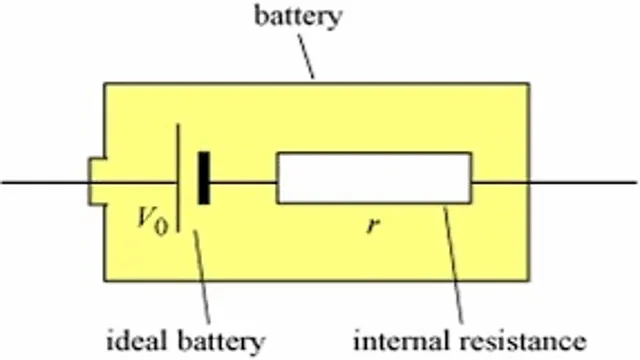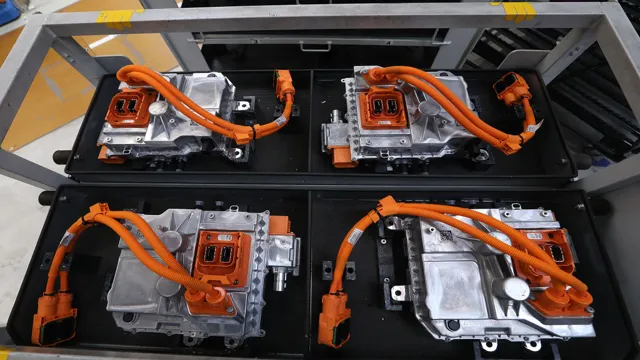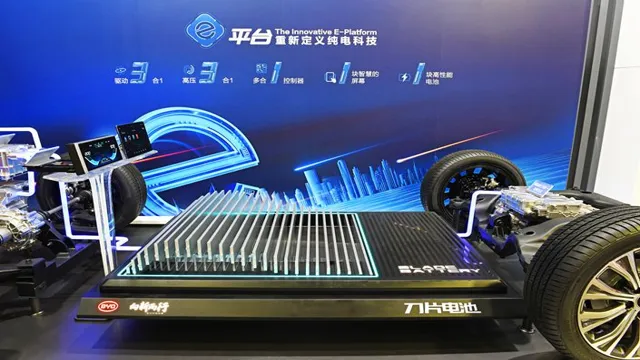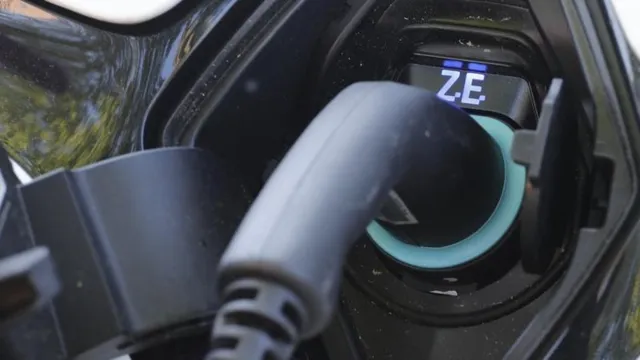Revving Up Your Knowledge: The Importance of Understanding Electric Car Battery Internal Resistance
Have you ever wondered how electric car batteries work? Well, in addition to their ability to store energy, one crucial factor that determines their efficiency is their internal resistance. This resistance is often affected by several factors, including temperature, battery age, and the number of charge and discharge cycles. To put it simply, the internal resistance of an electric car battery measures how difficult it is for the flow of electrons within the battery.
The higher the internal resistance, the harder it is for the battery to produce the required voltage to power the electric car. In this blog, we will discuss in-depth the importance of understanding the internal resistance of electric car batteries. You will learn how to measure internal resistance and how it can affect the overall performance of electric vehicles.
We will also explore how battery manufacturers are continually working to develop innovative technologies to reduce internal resistance and extend battery life. At the end of this blog, you will come away with an understanding of how the internal resistance of electric car batteries works, its significance in electric vehicle performance, and how it is being addressed in the electric car industry. So, sit back, relax, and join us as we dive into the world of electronic vehicle batteries and their internal resistance.
What is internal resistance?
Electric car battery internal resistance refers to the amount of opposition encountered by the flow of electric current inside the battery. This resistance can slow down the flow of electricity, which can affect the battery’s performance. Internal resistance can be caused by a variety of factors, including the size and material of the battery, temperature, and age.
Higher internal resistance can lead to a decrease in the battery’s overall capacity and a reduction in its lifespan. Electric car manufacturers and battery suppliers aim to reduce internal resistance in their products to ensure that vehicles have the longest possible range and battery life. By managing the internal resistance of electric car batteries, manufacturers can help to improve the efficiency and reliability of their products, ultimately making electric cars more appealing to consumers.
Definition and explanation
Internal resistance is a term commonly used in the field of electronics to describe the amount of resistance that exists within a battery or power source. This resistance is the result of many factors, including the materials used in the battery’s construction and the internal structure of the battery itself. Internal resistance is a crucial factor to consider when designing electronic circuits that rely on batteries for power, as it can have a significant impact on the accuracy and efficiency of these circuits.
A high internal resistance can cause a battery to discharge more quickly, reducing the overall lifespan of the battery, while a low internal resistance can result in more stable and reliable power delivery. Understanding the concept of internal resistance is essential for anyone working with electronic circuits, as it can significantly impact the overall performance and efficiency of those circuits.

Why is internal resistance important for electric cars?
When it comes to electric cars, the performance of the battery is crucial to ensure a smooth and efficient ride. Electric car battery internal resistance plays a significant role in determining the battery’s performance and longevity. The internal resistance refers to the degree of opposition the battery encounters when delivering power, and it affects the battery’s ability to supply energy.
A high internal resistance means that the battery struggles to transmit power, making the process less efficient and draining the battery faster. On the other hand, lower internal resistance translates to better efficiency, longer battery life, and ultimately, a more satisfactory driving experience for electric car owners. Therefore, electric car manufacturers aim to keep the internal resistance at an optimal level to maximize the battery’s performance and enhance the car’s overall efficiency.
Impact on performance and range
Internal resistance plays a significant role in the performance and range of electric cars. Simply put, internal resistance is the resistance within the battery that occurs as a result of the materials used to construct it. This resistance impedes the flow of electric currents within the battery, resulting in a reduction in the overall power output.
In electric cars, this means that the range of the vehicle can be affected, as well as the speed and acceleration. In addition, internal resistance can cause the battery to heat up, which can lead to further damage and reduce the lifespan of the battery. Therefore, it is crucial for manufacturers to develop batteries with low internal resistance, which can provide the necessary power without affecting the vehicle’s range and performance.
By doing so, they can ensure that electric cars are a viable and efficient option for consumers.
Measuring internal resistance
One of the essential factors in maintaining an electric car’s battery health is understanding its internal resistance. This is critical when determining if the battery is still functioning efficiently or needs to be replaced. Measuring the internal resistance of an electric car battery involves using specialized equipment that can detect any electrical resistance within the battery’s cells.
This information provides insight into the battery’s ability to hold a charge and perform optimally. A high internal resistance reading indicates a weakness in the battery, which may result in reduced driving range and overall performance. Thus, measuring the internal resistance is an essential step for anyone who wants to extend their electric car’s battery life and maximize their vehicle’s efficiency.
As such, regular battery testing is a recommended practice to ensure the optimal performance and longevity of an electric vehicle battery.
Techniques and instruments
Measuring internal resistance is a crucial part of testing the performance and stability of electronic devices. This process involves assessing how much opposition a device shows when electrical current flows through it. To measure internal resistance, you need a tool known as a multimeter.
A multimeter is a versatile instrument that can measure a range of electrical properties of a device, including voltage, resistance, and current. To get an accurate reading of the internal resistance, you would need to connect the multimeter to the device being tested and set it to measure resistance. Once connected, the device needs to be powered on and run for a while to ensure that the reading is stable and accurate.
Measuring internal resistance is crucial because it reveals potential issues that could affect the device’s performance or cause it to fail. By measuring internal resistance regularly, you can identify problems early on and address them before they become more significant issues that could lead to damage or failure.
Data analysis and interpretation
If you’re looking to measure the internal resistance of a battery, there are a few steps you can take. First, you’ll need to obtain a power supply and a resistor of known value. Then, connect the resistor to the positive terminal of the battery and the power supply.
Record the voltage across the battery and resistor using a multimeter. Next, calculate the current through the circuit by dividing the voltage across the resistor by its known value. Finally, use Ohm’s law to calculate the internal resistance of the battery by dividing the voltage across the battery by the current through the circuit.
It’s important to note that internal resistance can vary depending on the battery’s charge level and temperature, so it’s best to take multiple measurements to get an accurate reading. With these steps, you can measure the internal resistance of a battery and determine its overall health.
Factors affecting internal resistance
The internal resistance of electric car batteries is affected by several factors, such as temperature, age, and state of charge. Higher temperatures can cause the battery’s internal resistance to increase, which can lead to reduced performance and damage over time. As the battery ages, its internal resistance naturally increases, which can lead to decreased capacity and shorter lifetimes.
State of charge also plays a role, as higher levels of charge can lead to increased internal resistance. Additionally, the materials used in the battery’s construction can affect its internal resistance. Conductive materials, such as copper and aluminum, can decrease internal resistance, while insulating materials, such as plastic, can increase it.
Overall, careful management of these factors is crucial to maintaining the optimal performance and lifespan of electric car batteries.
Battery chemistry and design
When it comes to batteries, understanding internal resistance is important for optimizing their performance. Internal resistance refers to the amount of energy that is lost as heat within the battery due to its chemical composition and design. Several factors influence the internal resistance of a battery, including the electrolyte used, the thickness and surface area of the electrodes, and the temperature.
Generally, batteries with thicker electrodes and larger surface areas will have lower internal resistance, allowing them to deliver more power more efficiently. In contrast, batteries with higher internal resistance may struggle to deliver power quickly or may experience reduced capacity over time. By carefully selecting battery chemistry and design, it’s possible to optimize internal resistance for maximum performance and longevity.
Temperature and aging effects
Internal resistance is an essential characteristic of all batteries. It affects the performance of a battery, which ultimately results in reducing its lifespan. Temperature and aging effects are the primary factors that impact the internal resistance of the battery.
As the temperature increases, the internal resistance also increases, which leads to a more substantial power loss. Similarly, the aging of the battery causes a rise in its internal resistance, resulting in a shorter battery lifespan. Therefore, it is crucial to use the battery within the specified temperature range and replace it periodically to enhance its overall performance.
By doing so, you can ensure that your battery operates optimally, delivering the maximum power without any hindrance.
Improving electric car battery performance
If you’re an electric car owner, you may have heard about the importance of reducing the internal resistance of your car’s battery. Internal resistance refers to the resistance within the battery, which causes energy to be lost as heat rather than being used to power the car. The higher the internal resistance, the less efficient the battery operates, and the less mileage you achieve on a single charge.
Thankfully, there are methods to reduce internal resistance and improve battery performance. One way is to optimize the battery’s temperature – warmer temperatures decrease resistance. Regularly charging and discharging the battery can also improve its performance.
Additionally, using a higher quality charger and maintaining your car’s electrical system can help improve performance as well. By taking these steps, you can help your electric car reach its maximum potential and enjoy longer drives without worrying about recharging.
Strategies to reduce internal resistance
Improving electric car battery performance Electric cars are becoming increasingly popular, but one of the biggest obstacles to their widespread adoption is the limited range of their batteries. To improve electric car battery performance, one strategy is to reduce internal resistance. This resistance is caused by the flow of electrons through the battery, and it results in energy being lost as heat.
One way to reduce internal resistance is to use high-quality materials in the construction of the battery, such as copper wires and electrodes made from pure metals. Another strategy is to ensure that the battery is operating at the optimal temperature, which can be achieved through effective thermal management. Additionally, improving the design of the battery cells themselves can help to minimize internal resistance and maximize performance.
By implementing these strategies, electric car manufacturers can create batteries that are more efficient and have a longer range, making them a more attractive option for consumers.
Case studies of successful implementations
When it comes to electric cars, one of the biggest concerns is battery life. However, a recent case study showed that implementing a new technology can increase the performance of electric car batteries. Researchers tested a new electrode material, comprised of lithium cobalt oxide and lithium nickel manganese cobalt oxide, in a prototype battery and found that it doubled the energy density compared to traditional lithium-ion batteries.
This means that electric cars using this technology could travel twice as far on a single charge. Additionally, the new electrode material showed improved safety and stability during charging and discharging. With these promising results, it is exciting to consider the potential advancements in electric car technology and the positive impact it could have on the environment.
Conclusion
In conclusion, understanding electric car battery internal resistance is like knowing the ins and outs of your significant other – it’s not the most glamorous topic, but it’s crucial to a healthy relationship. Similarly, knowing the internal resistance of your car’s battery can help you optimize its performance and prolong its lifespan. Because at the end of the day, just like with relationships, taking care of the little things can make all the difference in the long run.
“
FAQs
What is the internal resistance of an electric car battery?
The internal resistance of an electric car battery determines the amount of power it can deliver. Generally, the lower the internal resistance, the better the battery performance.
How does the temperature affect the internal resistance of an electric car battery?
The internal resistance of an electric car battery increases as the temperature decreases. This means that in cold weather, the battery may not perform as well as in warmer weather.
Can a high internal resistance affect the range of an electric car?
Yes, a higher internal resistance can lead to a decrease in the range of an electric car battery, as it may not be able to deliver as much power to the motor.
How can a driver monitor the internal resistance of their electric car battery?
A driver can monitor the internal resistance of their electric car battery by checking the battery management system (BMS) in the car, which can report the current state of the battery and its internal resistance.






